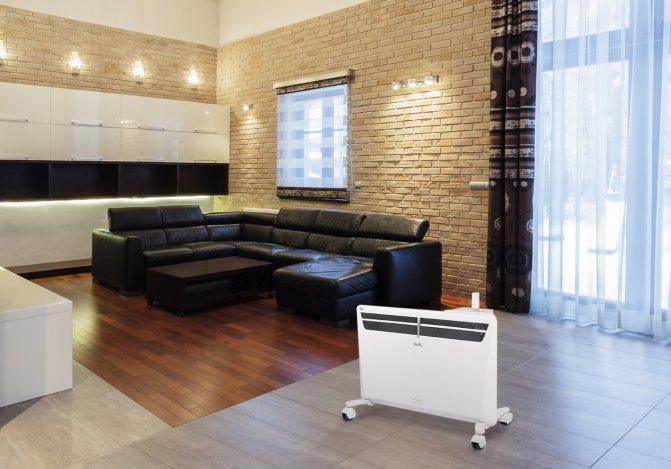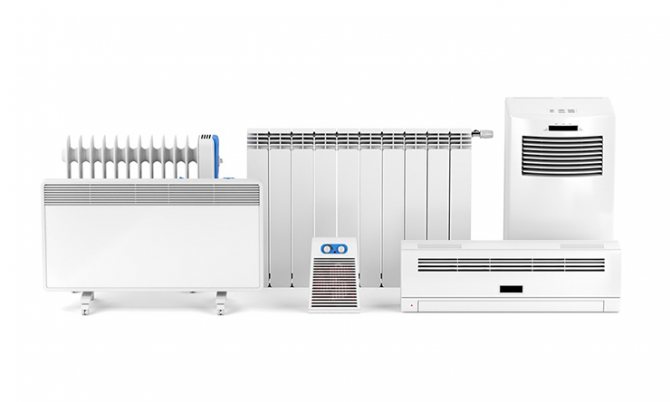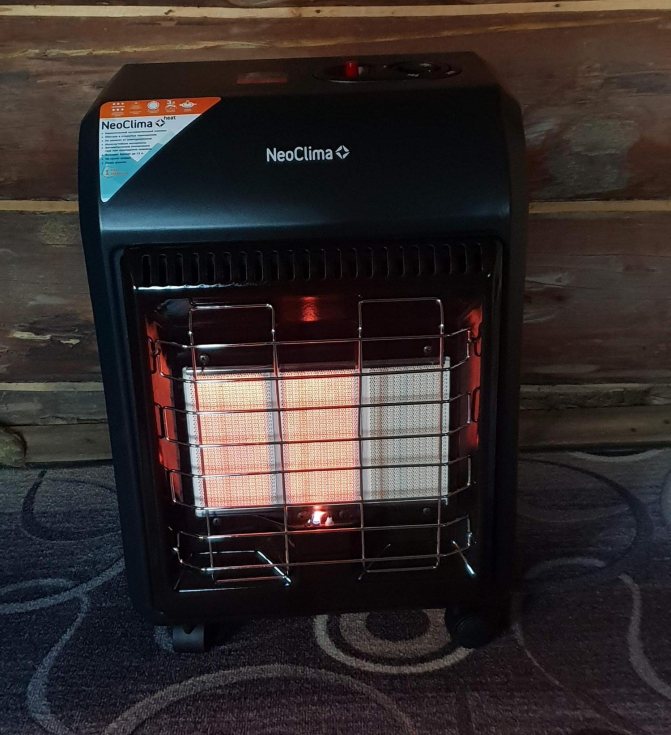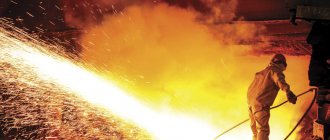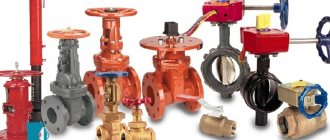Inverter heater
Operating principle
The inverter with which this type of device is equipped converts alternating current into direct current, while changing the voltage and frequency. This physical process is called inversion. The inverter looks like a periodic voltage generator. It is similar in shape to a discrete signal. Inverting has a profound effect on the power of the device, and all electrical appliances with it become less noisy and more economical.
Advantages and disadvantages
This type of device has enough advantages:
- Economical. When the inverter system of the device reaches the desired temperature level, the mechanism of the device does not turn off, but continues to work at low speeds. This leads to the maintenance of a favorable climate in the room. The heater does not need energy consumption for on and off functions. During the use of the inverter, there is no such thing as "high current" for starting. When the device is started, the current is not more than the rated one, which has a positive effect on the service life of the entire device. The device does not need to be constantly on and off. After all, these cycles significantly reduce the service life of the device. Compared to conventional appliances, the energy savings are around 40%.
- Practical and efficient. This device is capable of heating even at very low temperature conditions, while the beneficial effect is expressed by a high coefficient. The heater during operation shows the ratio of the released heat to the consumed energy, denoted as EER. This indicator for the device is equal to four. For example, at a consumption of 250 W, you get more than 1 kW of heat. This is a good indicator.
- During operation, the heater has high safety and environmental characteristics.
- Operation is carried out with a low noise level, this is due to a decrease in rotational speed at partial load. Without a doubt, this indicator has a positive effect on the life of the consumer.
A large number of advantages of the device does not deprive it of its shortcomings, but it is only one. This is a considerable cost of the heater in comparison with other similar devices.
Use in heating systems
Today, the inverter device is successfully used in heating systems, the power source of which is electricity. This innovation has earned a lot of positive reviews. It is installed wherever there is an electrical connection. It is possible to use inverter heating without permits, in particular, you do not need to obtain permission to install a heating system. A pleasant moment for consumers is the cost of equipment, which turned out to be much less than other heating systems.
A conventional gas boiler these days is easily replaced by an inverter heater. Then the operation of the heating system with the implemented inverter device will be as follows: passing through the heater, electricity enters the boiler. In this case, the inverter boiler constantly produces an induction current. If a power outage occurs, the boiler will continue to operate on battery power. The heater includes a magnetic part and a heat exchanger.
Main characteristics

The service life of inverter heaters is higher due to the absence of peak loads
The installation converts the incoming alternating current into direct current, and then again converts the direct current into alternating current, but with different characteristics. As a result, the device does not work with mains electricity, but with a current with improved performance. Thus, damage to the device during voltage surges is excluded: the heater lasts longer, works with greater efficiency.
The scheme of work is also changing. A conventional heater, when turned on, heats the air to the specified temperature, and when it is reached, it turns off completely. When the sensor signals a decrease in room temperature, the device turns on again. However, starting up the instrument will cause a short-term peak load. This mode contributes to the rapid wear of parts.
An inverter home heater works differently. When turned on, the heater heats up the air to the specified temperature, but after reaching it, it does not turn off, but reduces the operating power to 5–10%. When the temperature drops below the marked value, the heater increases its power.
In this mode, the power gradually increases and decreases, and there are no peak loads. The temperature also changes more smoothly, which allows for longer shutdown times and lower electricity consumption.
Frequently asked questions about electric convectors
Which convectors are more efficient - high or low?
The efficiency of the device does not depend on its size, but on the power. All kinds of "form factors" of equipment are created, first of all, for the convenience of its fitting into various interiors.
Is it dangerous to leave the convector unattended?
Definitely not. As long as your home's electrical wiring is capable of handling the combined power of concurrent appliances, you have nothing to worry about.
Can the convector be used as the main source of heating?
As a rule, yes. It all depends on the specific equipment model and manufacturer's recommendations.
Is an electric convector a suitable choice for a children's room?
Quite. Among the products of most popular manufacturers there are units designed specifically for children's rooms - with a solid body, with streamlined shapes, without sharp corners. The holes in them are as small as it is, in principle, possible - all so that the child could not shove anything inside.


Many modern manufacturers of electric heating convectors offer heating equipment models adapted specifically for children's rooms - well-designed and as safe as possible.
How to install the convector correctly
Installation regulations, requirements and restrictions are detailed in the instruction manual. In particular, it states:
- Installation of a gas convector in a wooden house. During operation, the case heats up to 50-55 ° C. It is necessary to insulate wooden surfaces in contact with heating parts of the structure. Installation rules in a wooden house prescribe the manufacture of fireproof roof gaps. If a coaxial pipe is used, insulation is not required at the place of passage through a wooden wall. The surface of the coaxial chimney heats up slightly due to the special design of the burner and pipe.
- Location from the floor. Air heating of a country or residential building has certain features that affect the efficiency of heating. For maximum performance, install the convector as close to the floor as possible. As a result of this solution, the intensity of circulation of convection flows increases and the efficiency of the equipment increases.
- The gas pipe is supplied to the heater exclusively along the street. A shut-off valve must be installed at the connection point.
A test run is carried out in the presence of a gas service representative.A corresponding note is made in the convector's documentation.
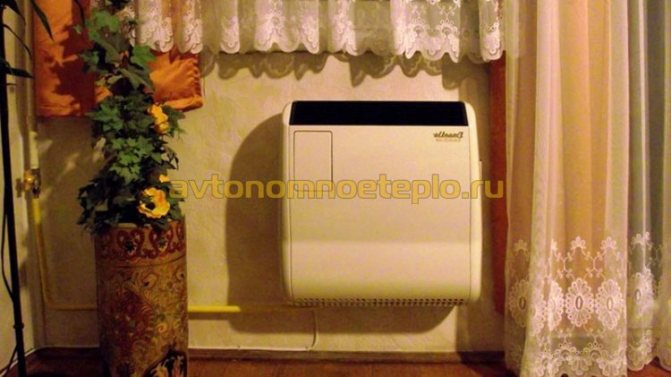

Which is better, a gas convector or a boiler
It all depends on the technical characteristics of the building and the features of its operation. The assembly of the convector requires less time and money.
Air heating is recommended for use in country houses that are not heated during the winter season. During installation, there is no need to use a water circuit, you can heat the building only from time to time. Even at a negative temperature in the room, you can warm up the room in 20-30 minutes.
A gas convector for a home on bottled gas is inferior to a boiler connected to a main pipeline in terms of efficiency, but superior in functionality. The choice of an air heater is justified in the absence of gasification. With a fully filled cylinder, the heater will work for approximately 10 days.
The convector heats the room better and faster and uses less fuel for this, but its efficiency is limited by the properties of convection flows. Heating intensity decreases as obstacles arise: walls, furniture, etc.
For heating a country house or small rooms, a convector-type heater is optimal. But for residential heated houses with large rooms, it is better to install a traditional gas boiler.
Calculation of the power and temperature of a warm water floor
Heater device and principle of operation
A gas heat convector is a device that is capable of generating heat through the combustion of gas. The design of the unit is quite simple.
- Burner. An igniter is connected to it.
- A heat exchanger, the task of which is to give off heat to the air passing through it. To heat more air, the heat exchanger is made finned (to increase the area).
- System for the removal of combustion products.
- The automation system is installed for safety purposes and shuts down the unit in case of problems in operation.
- The thermostat ensures the maintenance of the set temperature in the room.
- The housing is used to protect the device and is made of metal coated with heat-resistant paint.
The figure below shows the construction of a gas convector.


The principle of operation of the apparatus is that the gas, when burned in the chamber, heats the heat exchanger. The air flow, passing through the lower openings of the unit, moves through the heat exchanger, takes heat and exits heated into the room through the upper openings. Meanwhile, the combustion products of the gas are removed from the chamber through a double-walled (coaxial) pipe. Through it, fresh air enters the apparatus from the street to maintain the combustion process.


The principle of operation of the convector
The principle of operation of the inverter boiler
Standard electric boilers operate on the principle of energy transfer to the heat carrier. Transfers are carried out using heating elements. If a heating element is installed in the equipment, then a place for heating water should be foreseen in advance, protection of the heating element from corrosion and possible heat losses should be taken into account.
Inverter electric boilers work on a different principle. It works by electromagnetic induction. For this system to work, it is necessary to convert direct current into alternating current from the electrical network. The inverter runs on batteries or mains. With the help of an alternating magnetic field, the process of current generation takes place.
An inverter electric boiler can have 2 counterparts:
- A heat exchanger that heats the heat carrier.
- Magnetic that generates an alternating magnetic field.
- When AC is applied, this is how a magnetic field is created using a coil. Thus, the water that is in the pipelines is heated.
Types of electric convectors heating
When choosing climatic technology, it is important to take into account that electric convectors may differ from each other in the following characteristics:
- Mounting type.
- The heating element used.
You should also pay attention to the manufacturer of the product and the cost of electricity.
Types of electric convectors, according to installation features
Air convection heaters can be divided into three categories.
Wall mounted. Wall-mounted convectors are the most efficient. The location on the wall facilitates the convection process and increases the efficiency and heat transfer of the heaters.


Floor-standing version - used as an additional source of heat. Models with a built-in fan differ in performance. The convector with forced air circulation cannot boast of quiet operation, but it warms up the air well. Universal models - can be installed on the floor and mounted on the wall using special mounts. When choosing, you should pay attention to the presence of wheels in the kit. By installing the wheels on the body, you can easily move the heater anywhere in the room.
The main advantage of the convector is the low heating of the device body. This allows you to install a heater for heating a wooden house.
Classification of convectors according to the heating element used
In total, three types of heating elements are used. The design of the heating element affects the ability to operate the heater.
- Needle heating element is a simple design, it is a chromium-nickel heating thread located in a dielectric plate. The top is covered with a special insulating varnish. The heater with a needle heating element is not suitable for wet rooms, since the heating element has absolutely no protection against the ingress of water, steam, condensation and other liquids. As a rule, budget models are equipped with a needle heating element.
- Tubular heating element - manufactured in a waterproof design. The structure consists of a steel tube filled with a heat-conducting backfill, which is also an insulator. To increase heat transfer, heat-distributing fins are fixed on the sides of the heating element, increasing convection. The heaters are equipped with overheating protection. As a disadvantage of the tubular heating element, one can single out the fact that the electric convector heats up for a long time. The operation of the appliance may be accompanied by sounds resembling the crackling of burning wood.
- Monolithic heating element - the most economical electric convectors for heating a private house use a monolithic type heating element. The body of the heating element has no seams, the work does not accompany extraneous noise. If it is planned to make the electric heating of the apartment with convectors the main one, then the models with a monolithic heating element are the best solution. During operation, minimal heat loss is observed. The heater efficiently and quickly heats the room. The only noticed drawback of a monolithic heating element is the high cost of the device.
For space heating using an electric convector, it is better to choose devices that have a tubular or monolithic heating element and are equipped with a built-in electronic or programmable thermostat.
Heat exchanger material
The operation of the convector is based on the combustion of gas in the heat chamber of the unit, while the heat exchanger from the inside is exposed to a powerful thermal effect, its burnout quickly disables the convector. Therefore, it is natural that the material of manufacture should be as strong and stable as possible.
Here the undoubted leader is cast iron. The cast iron heat exchanger is thermally stable, the service life of such convectors is up to 50 years. Another plis of a cast-iron heat exchanger is a more even distribution of heat and slower cooling.The downside is the large mass and high price indicator.
Convectors with a steel heat exchanger are lighter and cheaper than cast iron
When buying, you should pay attention to the quality of the steel, such a gas convector serves for at least 20 years
Heater selection
In terms of function and appearance, inverter heaters are no different from ordinary ones. Is that gas models are slightly smaller in size. Selection recommendations relate not so much to the purpose of the heater, but to assess its quality. Pay attention to the following:
- quality certificates - a certificate must be attached to the inverter device;
- batch number - in the marking of each product, special symbols and numbers are indicated, which make it possible to find out the origin of the device;
- reliability of contacts;
- CE mark - indicates the safety of the product for human health - this is how devices that comply with EU standards are marked;
- wires - to prevent a fire in case of short circuit or damage, the wires for the heater are made of materials that do not support combustion - when ignited, they smolder for a few seconds, go out and melt the short circuit.
Which of the inverter modules is needed - a converter, an IR heater, a heat pump - is decided based on the area of the room, convenience, and economic considerations.
Heating convector, what it is and how it works a detailed overview
A little has already been said about the principle of work, now let's take a closer look. Any electric convector is based on the principle of movement of air masses in a room. We all know that cold masses go down, and warm ones are a little higher. The developers of the heaters took advantage of this by placing openings for cold air in the lower part of the device. The air-type heating element heats up quickly, which is its main feature. The most important thing is that the heated air is lighter and does not have any harmful impurities. Warm masses are discharged through the center and top vents in the enclosure. This solution allows you to increase the room temperature in the shortest possible time. It often takes just a few minutes to heat a small room with a medium-power convector.
How to choose a gas convector
Attention should be paid to the technical characteristics of the heaters. The best option is to choose a convector with a closed-type cast-iron heat exchanger and a programmable control unit.
When choosing equipment, you will need to consider the following:
- Power calculation. Air convection is used to heat the room. Consequently, heaters are only effective in confined spaces. For each room, you will need to install a separate convector. The power is calculated according to the formula 100 W per 1 m².
- Housing type. Heaters with a closed combustion chamber and exhaust of combustion products through a coaxial chimney are suitable for an apartment. You can put any type of equipment in your home. But when installing a heater with a closed chamber, it is necessary to take care of a constant and intensive supply of fresh air.
- Fuel type. It is forbidden to install a gas heating convector on liquefied gas in an apartment of a multi-storey building, due to the high explosion hazard of cylinders.
All convectors are initially manufactured with the ability to connect to the main gas pipeline. If you plan to connect the gas convector to the cylinder in the future, you need to purchase a special reducer (in some modifications it is included in the kit).
Types of gas convectors
To choose a suitable convector, you should learn about the main differences between existing equipment, the pros and cons of modifications.
What are the criteria for classifying heaters?
- Installation method - there are wall and floor models.The former take up less space, are lightweight and efficient, and are limited in performance (maximum power 10 kW). For heating a garage, rooms with a large area, it is better to choose a floor model. The heaters are heavy due to the enlarged heat exchanger. The performance of floor convectors reaches several mW (industrial versions).
- Exhaust gas removal. An open gas combustion chamber is installed in a conventional convector. The principle of the device is somewhat reminiscent of a simple wood-burning stove. The design has several disadvantages - it burns oxygen, requires good ventilation of the room, as well as the manufacture of a complex smoke exhaust system. New generation convectors use a closed combustion chamber. A coaxial pipe is used instead of a chimney. Air intake is carried out from the street, therefore, during operation, oxygen is not burned in the room. Systems with a closed combustion chamber have only one drawback - the cost is more than that of classic models by 30-50%.
- Heat exchanger material. The principle of operation of the convector is associated with constant thermal exposure. One of the most common reasons for a heater failure is the burnout of the chamber walls. The heat exchanger is made of steel or cast iron. The crystal structure of the latter metal provides a long service life (about 50 years) and high heat transfer. The steel chamber will work for about 10-15 years.
- Fan. High power convectors are equipped with a forced air circulation system. Budget household models may not have a fan.
- Gas type. The models are designed to operate on any kind of "blue" fuel. The natural gas convector can also be operated with propane. A special adapter kit is required for conversion.
- Control automation. Budget models are equipped with conventional thermostats. The programmable control unit allows you to control the room temperature and set the required heating mode.
The cost of a gas convector depends on the material of the heat exchanger, the availability of an adapter kit, and the characteristics of the control unit.
Advantages and disadvantages of inverter heating
Inverters in a broad sense are devices that convert direct current into alternating current, and their principle of operation is based on the phenomenon of electromagnetic induction. What is the difference between inverter heating and other types of heating systems?
The list of differences is pretty impressive:
- In the design of inverter boilers there are no moving parts and mechanisms, therefore, the durability of such devices is higher. Thus, the service life of inverter boilers is much higher than similar devices of another type and is usually at least 10 years.
- Inverter boilers have a fairly simple design, and if necessary, you can assemble it yourself.
- The heating medium in inverter boilers heats up much faster than in any other heating system. The reason is simple: in inverter devices there is no usual heat exchanger, so all the heat energy goes to heating the coolant.
- Almost every inverter boiler can work with any type of coolant, since the working elements of the boiler do not come into direct contact with the coolant. The coolant can only affect the characteristics and performance of the heating system, but the boiler will operate normally.
- Inverter boilers are quite expensive: when compared with ordinary household appliances, an inverter boiler will cost at least 2-3 times more.
- Household inverter boilers are heavy, but the dimensions of such devices compensate for this disadvantage. In addition, the good shape allows such a structure to be placed almost anywhere.
- The boiler is regulated by complex electronic systems that will ensure continuous operation and control of the boiler parameters. Thus, despite the simplicity of assembling the boiler itself, in order to independently create the control elements, you will have to study electronics. The installation of electronic systems is mandatory, otherwise the equipment may be damaged and malfunctioned.
- Inverter heating devices do not create noise and belong to fire-safe devices: during operation, no fuel is used, due to which ignition can occur, and there are no moving elements.
- Such systems are environmentally friendly: since no fuel is used, there are no emissions into the environment, because there are no combustion products.


Appointment
A natural gas-fired convector is intended for heating premises for various purposes. In this case, combustion occurs in a closed chamber, air is supplied from the street and combustion products are discharged there. The heat released during fuel combustion is transferred to the combustion chamber housing and heat exchanger, and then to the indoor air. Due to the rapid heating, the air rises up, making room for a colder one, maintaining an active convection process throughout the room.
The gas convector warms up the air faster and more actively than its electric counterparts, or even more so converter-type radiators for a water heating system. This is due to the higher surface temperature of the heat exchanger and the increased rate of heat transfer from the combustion chamber.
The gas convector is an excellent solution in the following situations:
- Primary heating of a small room or a house with one or two adjoining rooms.
- As a replacement for the solid fuel stove, which was previously used to heat the house.
- For quick warming up and maintaining a comfortable temperature in a garage, utility room, small country house.
- As a supplement to the central heating system in rooms where the installation of a water radiator is difficult (basement and basement, attic, veranda, etc.).
- For heating greenhouse facilities.
As a replacement for the main heating, a gas convector is suitable only for small houses or individual rooms. The efficiently heated area is easily calculated based on the models of gas convectors available in terms of power. On sale, devices with a power of 2.5-6 kW are more common, less often up to 12 kW. In the first case, the convector is enough to heat a room up to 50 m2. The most powerful models are in demand only for industrial and public premises up to 100 m2.
Toshiba RAS-07EKV-EE / RAS-07EAV-EE - quality and reliability


Installation of an inverter air conditioner from the EKV model range will provide heat to rooms up to 20 sq. m. The design of the model allows it to look good in any interior. The low level of noise generated during operation does not interfere even at night.
The panel of the device is made smooth for better serviceability. And the work of both indoor and outdoor units is practically silent. The noise level in the manned room does not exceed 26 dB.
Among other features of the model are the presence of a self-cleaning pallet and several operating modes. In an economical air conditioner, it consumes no more than 200 W, in a normal one - 550 W. There is the possibility of automatic start, operation in dehumidification mode, turbo mode for quick heating or cooling.
Another useful option is a timer that turns on or off equipment at a specified time. Equipment operation information is displayed on the LCD screen for easy operation.
List of advantages of energy-saving technology:
- quiet operation of outdoor and indoor units;
- ease of use - even an inexperienced user can figure out the settings;
- remembering the settings set by the user;
- anti-ice system that allows you to turn on the equipment even at low outdoor temperatures.
Disadvantages:
- the length of communications (10 m), which may not be enough for installation in some premises;
- a price that exceeds the cost of other heaters of similar power.
| The convenience of use | 9,6 |
| Ease of customization | 9,4 |
Gas convector
A wide variety of devices and heat sources are now used for heating premises for any purpose. All possible versions and operating principles are involved, from electric heaters, gas boilers to the use of geothermal energy. Among this variety, there is also a heating gas convector. This device outwardly resembles a conventional radiator, only slightly larger and runs on mainline natural or liquefied gas. Water is not heated in it, followed by distribution through the radiators, the heat from the combustion of gas through the heat exchanger immediately enters the room.
It is interesting to understand the features of this type of heaters and determine the scope of its application based on the advantages and disadvantages of a gas convector.
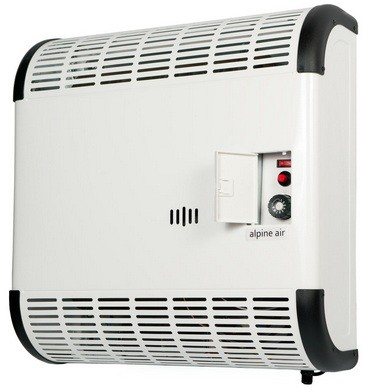

About the advantages of electric convectors
It is impossible not to highlight this aspect, since it is necessary to clearly understand what the pros and cons of such equipment. The main advantage is that the efficiency reaches 95%. This means that the consumed electricity is almost completely converted into heat. Quiet operation is another important point. For many, this factor is decisive, for obvious reasons. If you come from work to a cold apartment, then you need to heat it up as quickly as possible. The convector will best of all cope with the solution of this issue. The device does not need to waste time heating the media. It is enough to wait just one minute, and the unit will operate at the set temperature. One cannot but mention the cost of equipment, which is much less than that of gas boilers, oil heaters, etc.
Main advantages


Inverter heaters have many advantages, among them a special mode of operation is distinguished. Due to the fact that the system has an inverter, after reaching a certain temperature, the mechanism does not turn off, but continues to operate at a less impressive speed. At the same time, a favorable microclimate is maintained in the room. The device does not consume energy for switching off and on processes. Inverter heaters, reviews of which you can read in the article, should be purchased only after a thorough study of the quality characteristics of the equipment.
When using an inverter, there is no concept of high current during starting. At start-up, the current is not higher than the rated one, which has a beneficial effect on the service life of the device. Due to the above-described qualities, inverter heaters do not need to be switched off and on all the time. These cycles reduce the operating time of the device. Energy savings range from 30 to 50% when compared with conventional appliances.
Some general information about the device
In Europe, many have been using electric heating for quite some time. In our country, due to high electricity prices, this is problematic. Nevertheless, you need to somehow warm up, and therefore buying a convector is one of the best solutions. The principle of operation of the device is quite simple. The essence lies in the natural convection of air passing through the heating element. Heating equipment of this type has a small shape, which allows it to be placed where it is convenient. Today there are both floor-standing and wall-mounted options. In most cases, the shape is rectangular, although there are also squares, etc. So what are convectors, you ask? This is a device that has many holes in its body.Cold air enters the side and bottom, then it heats up and exits through the holes on the front side.


How the convector works
The principle of operation of a gas convector is based on the change in the properties of the gas with an increase in its temperature.
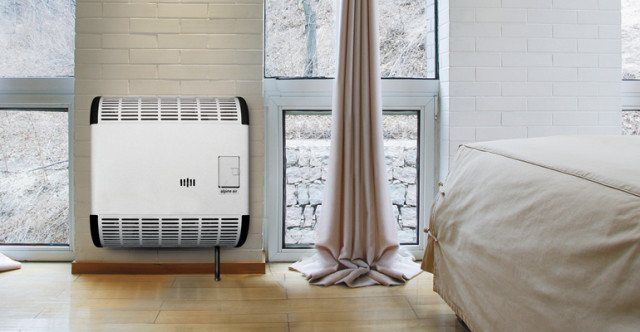

Pre-assembled gas convector
Passing through the convector's heat exchanger, the air heats up, becomes lighter and rises higher, and new portions of cold air come in its place. This movement of air layers is called convection, hence the name of the device.
Internally, the device and the principle of operation of this heater uniquely determine the way of its placement: it is best to install the convector as low as possible, then its efficiency will be greatest.
The fact is that the coldest air, due to its density and greater weight, is always at the bottom, and it will heat up in this configuration in the first place. In practice, a gas heating unit is most often tried to be mounted under a window, where heat loss is usually maximum.


The principle of operation of a gas convector
Gas heaters are often equipped with a tangential fan. Its installation helps to increase the rate of supply of heated air and significantly speed up the process of warming up the room. In addition, some expensive models have an increased thickness of the walls of the case and, therefore, are able to accumulate significant amounts of heat, and then transfer it to the surrounding space using thermal radiation. Such devices combine the advantages of conventional radiators and convectors and provide the highest heating quality.
Inverter air conditioner heater
The simplified common name for such devices "air conditioner" is misleading regarding the functionality of these units. Indeed, one of the functions of this device is to lower the air temperature in the room to the set value in the summer. However, the unit can also perform the opposite function - to heat the room in the cold season.
Device and principle of operation
To understand the principle of operation of an inverter heater, consider the operation of an air conditioner without an inverter in the design, but still a modern design that does not use air from the street. The inverter heater has the same operation algorithm, only improved.
The principle of operation of both of these devices is based on the release of heat by a gas during compression and cooling by a liquid of surfaces in contact with it during evaporation. The gas that plays this role in air conditioners is called a refrigerant.
Refrigerant properties
As a refrigerant in split systems, a fluorine-containing compound is used - freon, which is of more than 40 types. We list the 3 most common types of freon:
- R-22 is an ineffective refrigerant at temperatures below -5 and above 40 degrees (boiling point -41 degrees), due to the increased harmful effect on the ozone layer, prohibited for use in Russia;
- R-410A is a substance (boiling point -51 degrees) of a lesser negative effect on the ozone layer, effective for use in the temperature range from -15 to +45 degrees, used in most air conditioning systems;
- R-32 is a safe, state-of-the-art refrigerant (boiling point -52 degrees), with an efficiency of use 5% higher than R-410A.
Important!
When buying an air conditioner of any type, especially a used one, it is necessary to exclude the possibility of buying a device on the R-22 refrigerant, due to the prohibition of using the current deficit, which, if necessary, cannot be replaced with another type of freon.
Functions of the constituent units of the air conditioner
A modern air conditioner, called a split system, consists of two units. This division into two components made it possible to remove a more noisy and, moreover, bulky unit from the room, leaving a compact and, as a rule, aesthetically executed unit inside. Freon is moved by a pump located in the outdoor unit.


The principle of interaction of blocks of a split system
The internal block of the split system contains a heat exchanger (condenser). In the operating mode of the air conditioner for heating, the freon is compressed in the heat exchanger, at which its temperature rises.The temperature of the compressed refrigerant reaches 80 degrees, and heat is transferred to the room through the circulation of room air through a heat exchanger. After the release of heat, the compressed freon turns into a liquid state (condenses) and moves to the outdoor unit - to the evaporator, in which the pressure is ten times lower. A sharp drop in pressure leads to the boiling of the refrigerant with simultaneous absorption of heat from the environment. The boiling point of liquefied freon (depending on the type) with a large pressure drop is several tens of degrees below zero, that is, the outside air at a temperature of even -15 degrees is still warmer. Therefore, heat absorption by boiled freon occurs even from frosty air, and the lower the tabulated boiling point of the refrigerant, the colder air it is able to take heat from.


